Africa Wild Insect Book: Antlions, Lacewings and Allies (Order: Neuroptera)
Upload your picture of a insect and add a description underneath. Please only do one species per post.
All entries will be edited and updated (additional photos and information will be added by moderators). New entries will be posted according to taxonomic order and the post date does not reflect the actual date of new posts.
AW Insect Book: Antlions, Lacewings (Neuroptera)
Moderator: Klipspringer
Index to Neuroptera
Africa Wild Insect Book: Antlions, Lacewings and Allies Index to Order: Neuroptera
The order Neuroptera, collectively known as “lacewings” comprises 17 families worldwide. 13 families are known from South Africa.
Suborder Hemerobiiformia
Superfamily Osmyloidea
Osmylidae (Osmylids, Osmylid Flies)
Superfamily Chrysopoidea
Chrysopidae (Green Lacewings) (formerly in Hemerobioidea)
Subfamily Chrysopinae
Tribe Belonopterygini
Chrysoperla sp. Green Lacewing viewtopic.php?f=247&t=3223&p=177368#p177368
Italochrysa impar Lacewing viewtopic.php?p=526107#p526107
Superfamily Hemerobioidea
Hemerobiidae (Brown Lacewings)
Superfamily Coniopterygoidea
Coniopterygidae (Dustywings, Dusty Lacewings)
Sisyridae (Spongillaflies, Sponge Flies) (formerly in Osmyloidea, tentatively placed here)
Superfamily Mantispoidea
Dilaridae (Dilarids, Pleasing Lacewings) (formerly in Hemerobioidea)
Mantispidae (Mantid Flies)
Rhachiberothidae (Thorny Lacewings, Mantid-like Berothids)
Berothidae (Beaded Lacewings, Berothids)
Suborder Myrmeleontiformia
Superfamily Nemopteroidea
Psycopsidae (Moth or Silky Lacewings) (formerly in Hemerobioidea)
Silveira jordani Mottled Silky Lacewing viewtopic.php?p=249637#p249637
Nemopteridae (Ribbonwings & Threadwings, Spoon-winged Laceflies, Thread-winged Laceflies )(formerly in Myrmeleontoidea)
Laurhervasia setacea Thread-wing Lacewing viewtopic.php?p=246637#p246637
Nemeura glauningi Spoonwing Lacewing viewtopic.php?f=247&t=3223&p=143546#p143546
Semirhynchia brincki Spoonwing viewtopic.php?p=177516#p177516
Superfamily Myrmeleontoidea
Myrmeleontidae (Antlions)
Centroclisis brachygaster Giant Antlion viewtopic.php?f=247&t=3223&p=175883#p175883
Crambomorphus kalaharicus viewtopic.php?f=247&t=3223&p=173941#p173941
Creoleon luteipennis Grassland Antlion viewtopic.php?p=266020#p266020
Creoleon mortifer Grassland Antlion viewtopic.php?f=247&t=3223&start=10#p178689
Creoleon sp. Antlion viewtopic.php?p=249046#p249046
Creoleon sp. Grassland Antlion viewtopic.php?p=266017#p266017
Creoleon sp. Grassland Antlion viewtopic.php?p=266018#p266018
Cueta sp. Longbody Antlion viewtopic.php?p=178758#p178758
Cymothales illustris Tree-hole Antlion viewtopic.php?f=247&t=3223&p=177368#p177369
Hagenomyia lethifer Gregarious Antlion viewtopic.php?f=247&p=176031#p176031
Hagenomyia tristis Striped Antlion, Gregarious Antlion viewtopic.php?f=247&t=3223&p=185419#p185419
Macroleon quinquemaculatus Large Pit-building Antlion https://www.africawild-forum.com/viewto ... 79#p491779
Myrmeleon alcestris Pit-building Antlion viewtopic.php?p=260001#p260001
Neuroleon sp. Antlion viewtopic.php?p=266014#p266014
Palparellus flavofasciatus Antlion viewtopic.php?p=490792#p490792
Ascalaphidae (Owlflies, Ascalaphids)
Ascalaphinae
Proctarrelabis involvens Split-eyed owlfly. viewtopic.php?f=247&t=3223&start=20#p478372
Haplogleniinae
Neomelambrotus striatus Hairy Owlfly viewtopic.php?f=247&t=3223&p=486838#p486838
Tmesibasis lacerata Blotched Long-horned Owlfly viewtopic.php?f=247&t=3223&p=143546#p143549
Lacewing Larva viewtopic.php?f=247&p=149405#p149405
The order Neuroptera, collectively known as “lacewings” comprises 17 families worldwide. 13 families are known from South Africa.
Suborder Hemerobiiformia
Superfamily Osmyloidea
Osmylidae (Osmylids, Osmylid Flies)
Superfamily Chrysopoidea
Chrysopidae (Green Lacewings) (formerly in Hemerobioidea)
Subfamily Chrysopinae
Tribe Belonopterygini
Chrysoperla sp. Green Lacewing viewtopic.php?f=247&t=3223&p=177368#p177368
Italochrysa impar Lacewing viewtopic.php?p=526107#p526107
Superfamily Hemerobioidea
Hemerobiidae (Brown Lacewings)
Superfamily Coniopterygoidea
Coniopterygidae (Dustywings, Dusty Lacewings)
Sisyridae (Spongillaflies, Sponge Flies) (formerly in Osmyloidea, tentatively placed here)
Superfamily Mantispoidea
Dilaridae (Dilarids, Pleasing Lacewings) (formerly in Hemerobioidea)
Mantispidae (Mantid Flies)
Rhachiberothidae (Thorny Lacewings, Mantid-like Berothids)
Berothidae (Beaded Lacewings, Berothids)
Suborder Myrmeleontiformia
Superfamily Nemopteroidea
Psycopsidae (Moth or Silky Lacewings) (formerly in Hemerobioidea)
Silveira jordani Mottled Silky Lacewing viewtopic.php?p=249637#p249637
Nemopteridae (Ribbonwings & Threadwings, Spoon-winged Laceflies, Thread-winged Laceflies )(formerly in Myrmeleontoidea)
Laurhervasia setacea Thread-wing Lacewing viewtopic.php?p=246637#p246637
Nemeura glauningi Spoonwing Lacewing viewtopic.php?f=247&t=3223&p=143546#p143546
Semirhynchia brincki Spoonwing viewtopic.php?p=177516#p177516
Superfamily Myrmeleontoidea
Myrmeleontidae (Antlions)
Centroclisis brachygaster Giant Antlion viewtopic.php?f=247&t=3223&p=175883#p175883
Crambomorphus kalaharicus viewtopic.php?f=247&t=3223&p=173941#p173941
Creoleon luteipennis Grassland Antlion viewtopic.php?p=266020#p266020
Creoleon mortifer Grassland Antlion viewtopic.php?f=247&t=3223&start=10#p178689
Creoleon sp. Antlion viewtopic.php?p=249046#p249046
Creoleon sp. Grassland Antlion viewtopic.php?p=266017#p266017
Creoleon sp. Grassland Antlion viewtopic.php?p=266018#p266018
Cueta sp. Longbody Antlion viewtopic.php?p=178758#p178758
Cymothales illustris Tree-hole Antlion viewtopic.php?f=247&t=3223&p=177368#p177369
Hagenomyia lethifer Gregarious Antlion viewtopic.php?f=247&p=176031#p176031
Hagenomyia tristis Striped Antlion, Gregarious Antlion viewtopic.php?f=247&t=3223&p=185419#p185419
Macroleon quinquemaculatus Large Pit-building Antlion https://www.africawild-forum.com/viewto ... 79#p491779
Myrmeleon alcestris Pit-building Antlion viewtopic.php?p=260001#p260001
Neuroleon sp. Antlion viewtopic.php?p=266014#p266014
Palparellus flavofasciatus Antlion viewtopic.php?p=490792#p490792
Ascalaphidae (Owlflies, Ascalaphids)
Ascalaphinae
Proctarrelabis involvens Split-eyed owlfly. viewtopic.php?f=247&t=3223&start=20#p478372
Haplogleniinae
Neomelambrotus striatus Hairy Owlfly viewtopic.php?f=247&t=3223&p=486838#p486838
Tmesibasis lacerata Blotched Long-horned Owlfly viewtopic.php?f=247&t=3223&p=143546#p143549
Lacewing Larva viewtopic.php?f=247&p=149405#p149405
Last edited by ExFmem on Fri May 08, 2015 7:17 pm, edited 3 times in total.
- nan
- Posts: 26466
- Joined: Thu May 31, 2012 9:41 pm
- Country: Switzerland
- Location: Central Europe
- Contact:
Re: AW Insect Book: Antlions, Lacewings - Photos & Descripti
Spoonwing Lacewing Nemeura sp., possibly Nemeura glauningi
Family: Nemopteridae
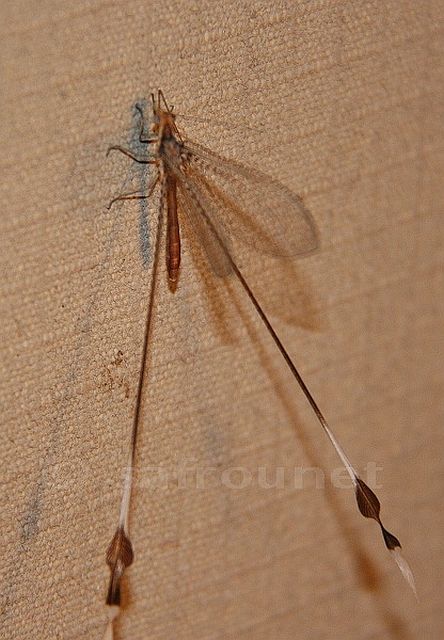
Kruger National Park
The NEMOPTERIDAE contains adults with ribbon-like hind wings some of which are ‘spooned’ at the end with white, brown and black markings. The long hindwings usually end in broad twisted dilations that provide aerodynamic stability during flight. They have long antennae that are not clubbed. The mouthparts of adults are elongated into a ‘beak’ to probe flowers for pollen and nectar. Their larvae, of many of which little is known, are predatory, have long necks and live in dust in areas of low rainfall. About 60 (which is most) of the world’s species occur in Namaqualand and the Karoo. Almost 70% of the world fauna is endemic to southern Africa.
The Nemopteridae contain two subfamilies:
Nemopterinae Spoonwings: ribbon-like hindwings, often with broad flairs at the tip, well marked;
Crocinae Threadwings: delicate, hindwings long, threadlike.
Nemeura glauningi is fairly widespread in the northern provinces of SA, Limpopo, Mpumalanga and North-West. It also occurs in several other African countries: Botswana, Namibia, Mozambique, Zambia, Zimbabwe, Malawi, Tanzania and Kenya.
It flies in October, and is readily attracted to light.
Links:
https://lacewing.tamu.edu/neuropterida/ ... s-4900.pdf
https://lacewing.tamu.edu/Biblio/Advanc ... files=true
Family: Nemopteridae

Kruger National Park
The NEMOPTERIDAE contains adults with ribbon-like hind wings some of which are ‘spooned’ at the end with white, brown and black markings. The long hindwings usually end in broad twisted dilations that provide aerodynamic stability during flight. They have long antennae that are not clubbed. The mouthparts of adults are elongated into a ‘beak’ to probe flowers for pollen and nectar. Their larvae, of many of which little is known, are predatory, have long necks and live in dust in areas of low rainfall. About 60 (which is most) of the world’s species occur in Namaqualand and the Karoo. Almost 70% of the world fauna is endemic to southern Africa.
The Nemopteridae contain two subfamilies:
Nemopterinae Spoonwings: ribbon-like hindwings, often with broad flairs at the tip, well marked;
Crocinae Threadwings: delicate, hindwings long, threadlike.
Nemeura glauningi is fairly widespread in the northern provinces of SA, Limpopo, Mpumalanga and North-West. It also occurs in several other African countries: Botswana, Namibia, Mozambique, Zambia, Zimbabwe, Malawi, Tanzania and Kenya.
It flies in October, and is readily attracted to light.
Links:
https://lacewing.tamu.edu/neuropterida/ ... s-4900.pdf
https://lacewing.tamu.edu/Biblio/Advanc ... files=true
Kgalagadi lover… for ever
https://safrounet.piwigo.com/
https://safrounet.piwigo.com/
Re: AW Insect Book: Antlions, Lacewings - Photos & Descripti
Blotched Long-horned Owlfly Tmesibasis laceratus
Family: Ascalaphidae
 © BluTuna
© BluTuna
The ASCALAPHIDAE contains adults with very long antennae with clubbed ends. They generally hold their abdomens at almost right angles to the surface, are often active fliers and predatory with well-developed jaws. They fly rapidly and hawk prey at dusk.
Larvae have strong curved mandibles with teeth. The larvae, which can open their pincer-like jaws to 180 degrees, do not construct pits but live under stones, bark or leaves from where they prey on other insects. They are all ambush predators, and highly cryptic.
There are about 50 species known from the region.
The patterned wings enhance its crypsis when at rest. Eggs are laid in batches on branches and twigs and the larvae live exposed, albeit well camouflaged, and are known as sit-and-wait predators.
Distribution
South Africa (Mpumulanga, Northern Province, North-West Province), Mozambique
Links: The Owlflies (Neuroptera: Ascalaphidae) of South Africa
Family: Ascalaphidae
 © BluTuna
© BluTunaThe ASCALAPHIDAE contains adults with very long antennae with clubbed ends. They generally hold their abdomens at almost right angles to the surface, are often active fliers and predatory with well-developed jaws. They fly rapidly and hawk prey at dusk.
Larvae have strong curved mandibles with teeth. The larvae, which can open their pincer-like jaws to 180 degrees, do not construct pits but live under stones, bark or leaves from where they prey on other insects. They are all ambush predators, and highly cryptic.
There are about 50 species known from the region.
The patterned wings enhance its crypsis when at rest. Eggs are laid in batches on branches and twigs and the larvae live exposed, albeit well camouflaged, and are known as sit-and-wait predators.
Distribution
South Africa (Mpumulanga, Northern Province, North-West Province), Mozambique
Links: The Owlflies (Neuroptera: Ascalaphidae) of South Africa
Hunting cannot be considered a sport as all contestants in a sport should know they are playing the game!
Re: AW Insect Book: Antlions, Lacewings - Photos & Descripti
Green Lacewing Larva Chrysoperla sp.
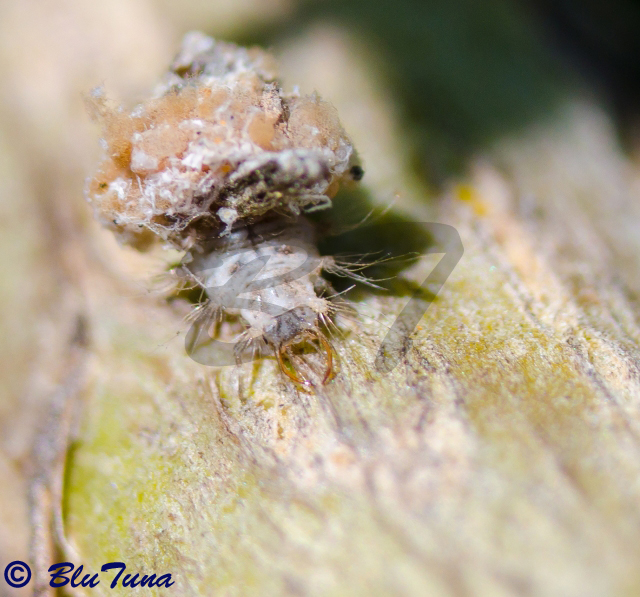 © BluTuna
© BluTuna
Garden in Johannesburg
Lacewings are characterized by several unique larval features:
Mouthparts in which the mandibles and maxillae fit together to form piercing and sucking tubes – the only insects with these specialized features.
The midgut is sealed and no solid waste is excreted during the larval stage.
A silken cocoon is spun from modified malpighian tubules.
All larvae are predators.
Some Lacewing larvae carry debris on their backs to avoid predators.
Chrysoperla species lay batches of stalked eggs, and the larvae often carry the empty skins of their prey in their backs to enhance camouflage - hence the name "trash carriers".
 © BluTuna
© BluTunaGarden in Johannesburg
Lacewings are characterized by several unique larval features:
Mouthparts in which the mandibles and maxillae fit together to form piercing and sucking tubes – the only insects with these specialized features.
The midgut is sealed and no solid waste is excreted during the larval stage.
A silken cocoon is spun from modified malpighian tubules.
All larvae are predators.
Some Lacewing larvae carry debris on their backs to avoid predators.
Chrysoperla species lay batches of stalked eggs, and the larvae often carry the empty skins of their prey in their backs to enhance camouflage - hence the name "trash carriers".
Hunting cannot be considered a sport as all contestants in a sport should know they are playing the game!
Re: AW Insect Book: Antlions, Lacewings - Photos & Descripti
Kalahari Antlion Crambomorphus kalaharicus
Family Myrmeleontidae. Subfamily Palparinae. Tribe: Palparini
The Family Myrmeleontidae is the largest lacewing family, comprising medium to very large (wingspan 26-160 mm) insects that superficially resemble dragonflies, but have short antennae usually ending in a club. Characteristic lazy, flapping flight. Most are attracted to lights in summer and autumn. Almost half the region's 125 species occur in arid western areas.
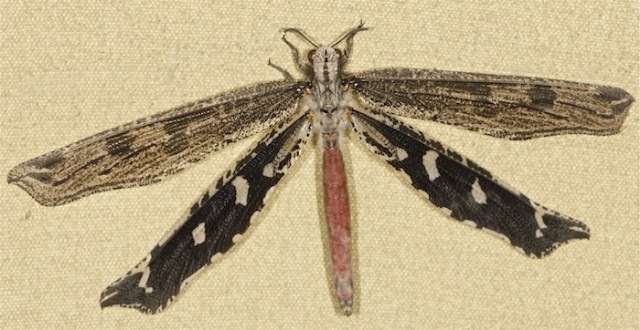 © ExFmem
© ExFmem
Genus Crambomorpus
The genus Crambomorphus McLachlan, 1867 includes some of the largest and most striking antlions. It is essentially endemic to the arid western regions of southern Africa (South Africa, Namibia, Botswana), but also with two species from Madagascar.
Four species names have historically been associated with Crambomorphus: C. sinuatus (Olivier) and C. haematogaster (Gerstaecker) from South Africa, and C. madagascariensis (van der Weele) and C. grandidieri van der Weele from Madagascar. Crambomorphus haematogaster is a synonym of C. sinuatus (Brauer 1867), reducing the hitherto known species to three.
All are large, cryptic, darkly coloured antlions with wings that are either narrow and sinuate or lanceolate with characteristic markings that enhance the camouflage of these magnificent insects. They are nocturnal in habit and the irregular outline of the wings and dark coloration render them extremely cryptic on narrow stems of shrubs and bushes when diurnally at rest with the wings folded. The three-toothed larvae of two species are known and have been found inhabiting deep sand.
Crambomorphus, and the Palparini in general, are a significant component of the insect fauna of arid and semiarid areas, where their biomass and large predatory larvae have an undoubted impact on populations of other invertebrates. Most taxa are also restricted to specific biomes, rendering them potentially important indicator species (Mansell 1999).
Diagnosis: Large Palparini, with characteristic narrow, sinuate or lanceolate, heavily-pigmented, densely reticulated wings; costal area usually with one or more irregular biaereolate or triaereolate cells. Head robust with raised vertex, distinct median stripe on head extending onto pronotum and mesonotum. The palpimacula on the terminal labial palpomere is a long slit that extends for much of the incrassate portion of the segment as far as the tip, but not beyond. Abdomen blood-red in living specimens. Male ectoprocts black, forcipate. Males with gonarcus and parameres complex fused into a cone-shaped structure, gonarcal bulla prominent, parameres pitch black sculptured with microscopic striations. CuP in forewings not
fused with A1; in hindwings CuA arches forward at junction with posterior branch of Mp fork, forming the typical palparine recurrent vein. All males with prominent pilula axilaris at base of the hindwing. Larvae characterized by reddish brown head and three mandibular teeth and thorax and abdomen black or pale with black markings.
Distribution
Crambomorphus kalaharicus is endemic to the Kalahari ecosystem of the Northern Cape Province of South Africa, Botswana and Namibia. It is centred and protected within the Kgalagadi Transfrontier Park of South Africa and Botswana.
Identification of Crambomorphus kalaharicus
Very large (wingspan 122 mm), body and legs grey, abdomen orange-red. Hind margin of wing very scalloped, ending in a hooked tip. Fore wings largely grey, with complex black and white markings; hind wings heavily marked in black. Larvae largely black with reddish head.
Head: wider than prothorax, vertex raised, pale brown, densely speckled with black maculae and clothed with dense white recumbent setae; median black stripe extends from vertex broadening posteriorly over prothorax; frons yellow with recumbent white setae; black markings extend below toruli, clypeus and labrum yellow. Eyes large, greater than hemispherical. Antennae slightly longer than head width, black, densely clothed in short black setae.
Thorax: prothorax short, much wider than long, pale yellowish-brown with central black stripe, a small spot on either side, lateral margins black, anterior margin raised, finely spotted, with dense fringe of long white anteriorlydirected setae and black setae posteriorly, hind margin raised with long white and black setae. Mesothorax covered with long white and black pubescence, a central black stripe divided posteriorly, black patches above wing bases. Metathorax mostly black with long white recumbent setae and velvet patches anteriorly.
Wings: very narrow, marked with brown, hind margins of both fore- and hind wings characteristically sinuate, with markedly acute falcate tips (Figs 16, 17); crossveins pale yellow, R with alternating black and yellow; pterostigma miniscule, hardly discernible. Forewings with four light-brown markings; basal mark large, diffuse, apical mark divided, posterior margin with very narrow sinuate pale brown stripe in apical half. Hind wings brown with three pale incomplete bands and pale areas basally and in costal area.
Legs: black with faint pale patches on tibiae, densely covered with short white and black spinose setae; forelegs with dense setal brush on tibiae, tibiae longer than tarsi in all legs, tibial spurs slender, black, curved.
Abdomen: shorter than hind wings, red in living specimens, clothed with short black setae, with some long white setae on T1 and anterior margin of T2.
Biology
The large black larvae live freely in sand dunes in the Kalahari ecosystem and come to the surface at night to feed. They have been excavated by sieving, usually several centimetres below the surface. It is possible that they either actively hunt on the surface at night or are crepuscular
ambush predators just below the surface, with the red dorsum of the head and prothorax blending with that of the surrounding red Kalahari sand. Their black coloration provides a stark contrast to larvae of Golafrus oneili (Péringuey) and Annulares annulatus (Stitz), which occur in the same habitat but are predominantly white. This leads to the conclusion that C. kalaharicus larvae are largely crepuscular and nocturnal,
whereas the latter two species spend more time near the surface during daylight, with their white coloration being an adaptation to radiate heat thereby enabling them to tolerate the high surface temperatures more effectively. The dark coloration of C. kalaharicus probably is an adaptation to heat retention by surfacehunting nocturnal predators. Adult flight period October to early January.
Habitat
Very arid regions with scant vegetation
Predators
Predators of lacewings include birds, bats, reptiles, and larger insects.
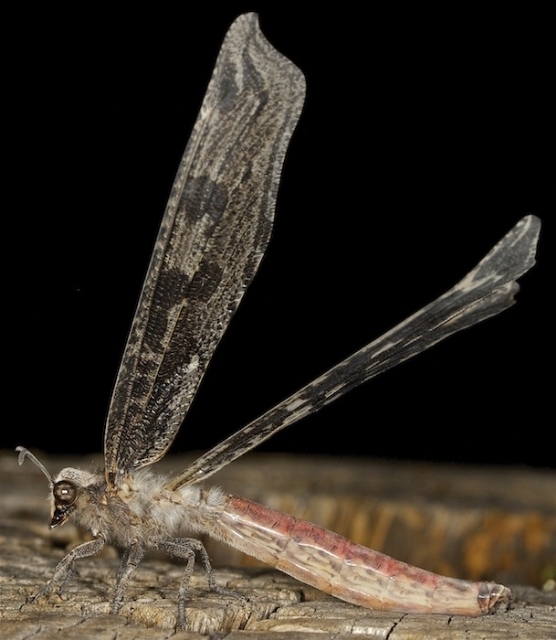 © ExFmem
© ExFmem
Female
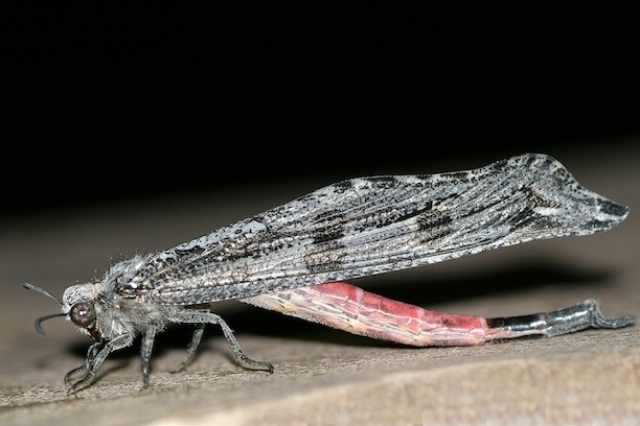 © ExFmem
© ExFmem
Male
 © ExFmem
© ExFmem
Kgalagadi Transfrontier Park, Kalahari Tented Camp
 © Tina
© Tina
Kgalagadi Transfrontier Park, Grootkolk
Links:
https://lacewing.tamu.edu/neuropterida/ ... -17495.pdf
Family Myrmeleontidae. Subfamily Palparinae. Tribe: Palparini
The Family Myrmeleontidae is the largest lacewing family, comprising medium to very large (wingspan 26-160 mm) insects that superficially resemble dragonflies, but have short antennae usually ending in a club. Characteristic lazy, flapping flight. Most are attracted to lights in summer and autumn. Almost half the region's 125 species occur in arid western areas.
 © ExFmem
© ExFmemGenus Crambomorpus
The genus Crambomorphus McLachlan, 1867 includes some of the largest and most striking antlions. It is essentially endemic to the arid western regions of southern Africa (South Africa, Namibia, Botswana), but also with two species from Madagascar.
Four species names have historically been associated with Crambomorphus: C. sinuatus (Olivier) and C. haematogaster (Gerstaecker) from South Africa, and C. madagascariensis (van der Weele) and C. grandidieri van der Weele from Madagascar. Crambomorphus haematogaster is a synonym of C. sinuatus (Brauer 1867), reducing the hitherto known species to three.
All are large, cryptic, darkly coloured antlions with wings that are either narrow and sinuate or lanceolate with characteristic markings that enhance the camouflage of these magnificent insects. They are nocturnal in habit and the irregular outline of the wings and dark coloration render them extremely cryptic on narrow stems of shrubs and bushes when diurnally at rest with the wings folded. The three-toothed larvae of two species are known and have been found inhabiting deep sand.
Crambomorphus, and the Palparini in general, are a significant component of the insect fauna of arid and semiarid areas, where their biomass and large predatory larvae have an undoubted impact on populations of other invertebrates. Most taxa are also restricted to specific biomes, rendering them potentially important indicator species (Mansell 1999).
Diagnosis: Large Palparini, with characteristic narrow, sinuate or lanceolate, heavily-pigmented, densely reticulated wings; costal area usually with one or more irregular biaereolate or triaereolate cells. Head robust with raised vertex, distinct median stripe on head extending onto pronotum and mesonotum. The palpimacula on the terminal labial palpomere is a long slit that extends for much of the incrassate portion of the segment as far as the tip, but not beyond. Abdomen blood-red in living specimens. Male ectoprocts black, forcipate. Males with gonarcus and parameres complex fused into a cone-shaped structure, gonarcal bulla prominent, parameres pitch black sculptured with microscopic striations. CuP in forewings not
fused with A1; in hindwings CuA arches forward at junction with posterior branch of Mp fork, forming the typical palparine recurrent vein. All males with prominent pilula axilaris at base of the hindwing. Larvae characterized by reddish brown head and three mandibular teeth and thorax and abdomen black or pale with black markings.
Distribution
Crambomorphus kalaharicus is endemic to the Kalahari ecosystem of the Northern Cape Province of South Africa, Botswana and Namibia. It is centred and protected within the Kgalagadi Transfrontier Park of South Africa and Botswana.
Identification of Crambomorphus kalaharicus
Very large (wingspan 122 mm), body and legs grey, abdomen orange-red. Hind margin of wing very scalloped, ending in a hooked tip. Fore wings largely grey, with complex black and white markings; hind wings heavily marked in black. Larvae largely black with reddish head.
Head: wider than prothorax, vertex raised, pale brown, densely speckled with black maculae and clothed with dense white recumbent setae; median black stripe extends from vertex broadening posteriorly over prothorax; frons yellow with recumbent white setae; black markings extend below toruli, clypeus and labrum yellow. Eyes large, greater than hemispherical. Antennae slightly longer than head width, black, densely clothed in short black setae.
Thorax: prothorax short, much wider than long, pale yellowish-brown with central black stripe, a small spot on either side, lateral margins black, anterior margin raised, finely spotted, with dense fringe of long white anteriorlydirected setae and black setae posteriorly, hind margin raised with long white and black setae. Mesothorax covered with long white and black pubescence, a central black stripe divided posteriorly, black patches above wing bases. Metathorax mostly black with long white recumbent setae and velvet patches anteriorly.
Wings: very narrow, marked with brown, hind margins of both fore- and hind wings characteristically sinuate, with markedly acute falcate tips (Figs 16, 17); crossveins pale yellow, R with alternating black and yellow; pterostigma miniscule, hardly discernible. Forewings with four light-brown markings; basal mark large, diffuse, apical mark divided, posterior margin with very narrow sinuate pale brown stripe in apical half. Hind wings brown with three pale incomplete bands and pale areas basally and in costal area.
Legs: black with faint pale patches on tibiae, densely covered with short white and black spinose setae; forelegs with dense setal brush on tibiae, tibiae longer than tarsi in all legs, tibial spurs slender, black, curved.
Abdomen: shorter than hind wings, red in living specimens, clothed with short black setae, with some long white setae on T1 and anterior margin of T2.
Biology
The large black larvae live freely in sand dunes in the Kalahari ecosystem and come to the surface at night to feed. They have been excavated by sieving, usually several centimetres below the surface. It is possible that they either actively hunt on the surface at night or are crepuscular
ambush predators just below the surface, with the red dorsum of the head and prothorax blending with that of the surrounding red Kalahari sand. Their black coloration provides a stark contrast to larvae of Golafrus oneili (Péringuey) and Annulares annulatus (Stitz), which occur in the same habitat but are predominantly white. This leads to the conclusion that C. kalaharicus larvae are largely crepuscular and nocturnal,
whereas the latter two species spend more time near the surface during daylight, with their white coloration being an adaptation to radiate heat thereby enabling them to tolerate the high surface temperatures more effectively. The dark coloration of C. kalaharicus probably is an adaptation to heat retention by surfacehunting nocturnal predators. Adult flight period October to early January.
Habitat
Very arid regions with scant vegetation
Predators
Predators of lacewings include birds, bats, reptiles, and larger insects.
 © ExFmem
© ExFmemFemale
 © ExFmem
© ExFmemMale
 © ExFmem
© ExFmemKgalagadi Transfrontier Park, Kalahari Tented Camp
 © Tina
© TinaKgalagadi Transfrontier Park, Grootkolk
Links:
https://lacewing.tamu.edu/neuropterida/ ... -17495.pdf
Last edited by Klipspringer on Sat Feb 08, 2020 2:34 pm, edited 2 times in total.
-
Klipspringer
- Global Moderator
- Posts: 5858
- Joined: Sat Sep 14, 2013 12:34 pm
- Country: Germany
- Contact:
Re: AW Insect Book: Antlions, Lacewings - Photos & Descripti
Giant Antlion Centroclisis brachygaster
Family Myrmeleontidae. Subfamily Myrmeleontinae. Tribe Acanthaclisini
 © Super Mongoose
© Super Mongoose
Marakele National Park, Bontle campsite's bathroom
Centroclisis adult antlions have a wingspan of 84 mm, stout-bodied, cryptically grey, hairy (hirsute), with broad and short wings.
Centroclisis brachygaster is widespread in sub-Saharan Africa.
Links:
https://lacewing.tamu.edu/SpeciesCatalo ... ObjID=1764
https://lacewing.tamu.edu/neuropterida/ ... s-1424.pdf
Family Myrmeleontidae. Subfamily Myrmeleontinae. Tribe Acanthaclisini
 © Super Mongoose
© Super MongooseMarakele National Park, Bontle campsite's bathroom
Centroclisis adult antlions have a wingspan of 84 mm, stout-bodied, cryptically grey, hairy (hirsute), with broad and short wings.
Centroclisis brachygaster is widespread in sub-Saharan Africa.
Links:
https://lacewing.tamu.edu/SpeciesCatalo ... ObjID=1764
https://lacewing.tamu.edu/neuropterida/ ... s-1424.pdf
Re: AW Insect Book: Antlions, Lacewings - Photos & Descripti
Gregarious Antlion Hagenomyia lethifer
Family: Myrmeleontidae
 © BluTuna
© BluTuna
 © BluTuna
© BluTuna
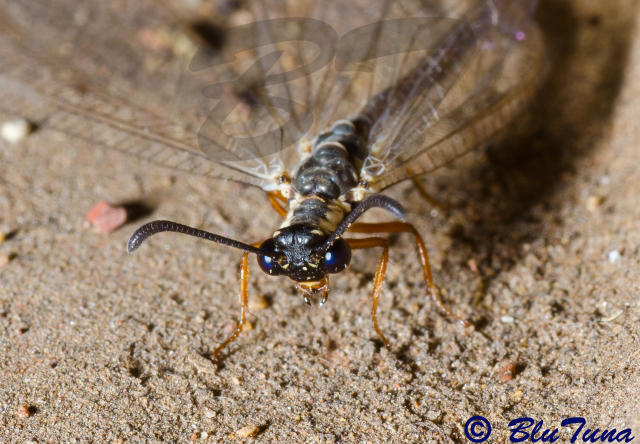 © BluTuna
© BluTuna
Hartebeeshoek, Gauteng
Description
Wingspan 60 mm, thorax and abdomen are black with cream sides and undersides, red legs.
The characteristically pink larvae construct pitfall traps often in open situations.
Distribution
Found in Eastern and Southern Africa.
Links: The Antlions (Neuroptera: Myrmeleontidae) of South Africa (Checklist)
Family: Myrmeleontidae
 © BluTuna
© BluTuna © BluTuna
© BluTuna © BluTuna
© BluTunaHartebeeshoek, Gauteng
Description
Wingspan 60 mm, thorax and abdomen are black with cream sides and undersides, red legs.
The characteristically pink larvae construct pitfall traps often in open situations.
Distribution
Found in Eastern and Southern Africa.
Links: The Antlions (Neuroptera: Myrmeleontidae) of South Africa (Checklist)
Hunting cannot be considered a sport as all contestants in a sport should know they are playing the game!
Re: AW Insect Book: Antlions, Lacewings - Photos & Descripti
Green Lacewing or Golden Eyes Chrysoperla sp.*
Family Chrysopidae
* "Possibly C. pudica, but cannot be sure." (Per ADU Virtual Museum Lacewing Project)

Nov. 2013 KTC in Kgalgadi
Identification
Medium sized (wingspan 24 mm), plain green, without spots or markings on wings. Eyes are metallic looking, hence the common name.
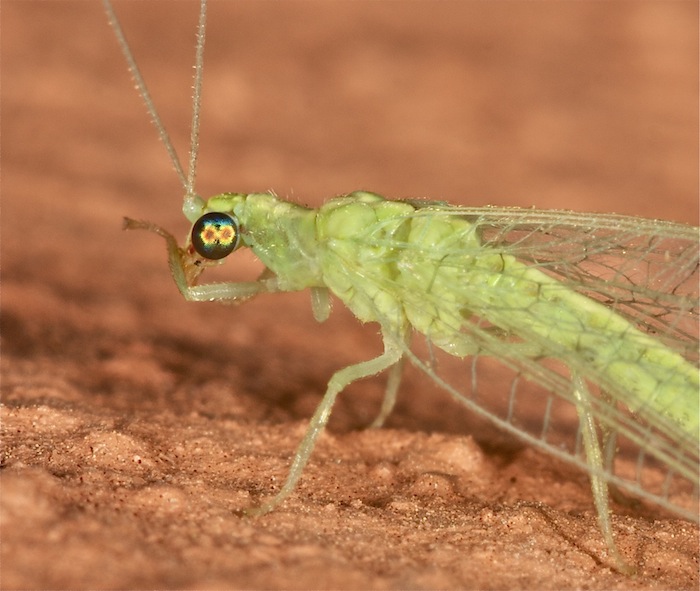
Distribution
Occurs in the whole southern Africa excepted the eastern coast: South Africa, Lesotho, Eswatini, Namibia, Botswana, Zimbabwe, Mozambique (M, Zambia.
Habitat
Found on a variety of vegetation types. Common in gardens.
Chrysoperla pudica is considered an arboreal species living most often in dry and stony countries with sparse vegetation, on Acacia, similar trees and bushes.

Oct., 2013 Nossob in Kgalagadi
Biology
Larvae feed on mealy bugs and other homopterans. Adults feed on honeydew and pollen, not homopteran bugs. Adults are attracted to lights. The larvae are highly beneficial insects as predators of other species, especially crop pests, and have been used successfully in biological control programs.
Links: Checklist: The Green Lacewings (Neuroptera: Chrysopidae) of South Africa
 © BluTuna
© BluTuna
Chrysoperla sp., possibly Chrysoperla pudica, garden in Johannesburg
Family Chrysopidae
* "Possibly C. pudica, but cannot be sure." (Per ADU Virtual Museum Lacewing Project)

Nov. 2013 KTC in Kgalgadi
Identification
Medium sized (wingspan 24 mm), plain green, without spots or markings on wings. Eyes are metallic looking, hence the common name.

Distribution
Occurs in the whole southern Africa excepted the eastern coast: South Africa, Lesotho, Eswatini, Namibia, Botswana, Zimbabwe, Mozambique (M, Zambia.
Habitat
Found on a variety of vegetation types. Common in gardens.
Chrysoperla pudica is considered an arboreal species living most often in dry and stony countries with sparse vegetation, on Acacia, similar trees and bushes.

Oct., 2013 Nossob in Kgalagadi
Biology
Larvae feed on mealy bugs and other homopterans. Adults feed on honeydew and pollen, not homopteran bugs. Adults are attracted to lights. The larvae are highly beneficial insects as predators of other species, especially crop pests, and have been used successfully in biological control programs.
Links: Checklist: The Green Lacewings (Neuroptera: Chrysopidae) of South Africa
 © BluTuna
© BluTunaChrysoperla sp., possibly Chrysoperla pudica, garden in Johannesburg
Last edited by ExFmem on Mon Apr 13, 2015 10:02 pm, edited 1 time in total.
Re: AW Insect Book: Antlions, Lacewings - Photos & Descripti
Tree-hole Antlion Cymothales illustris
Family Myrmeleontidae
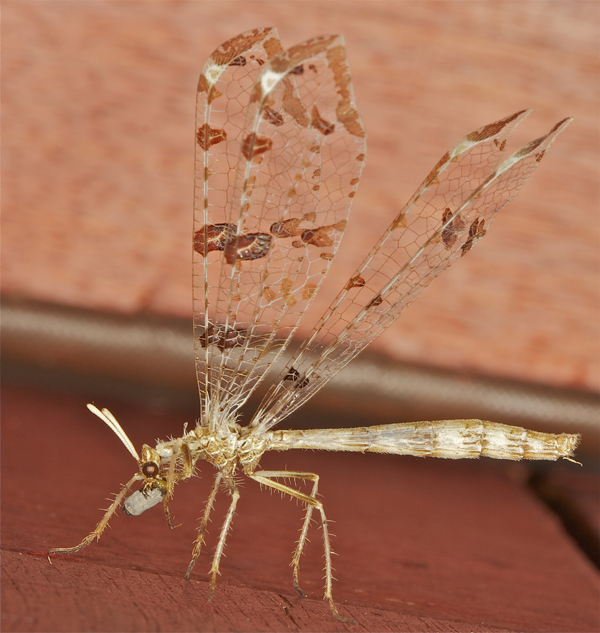
Kgalagadi 2019

Oct. 2013 Kgalagadi

Oct. 2012 Kgalagadi
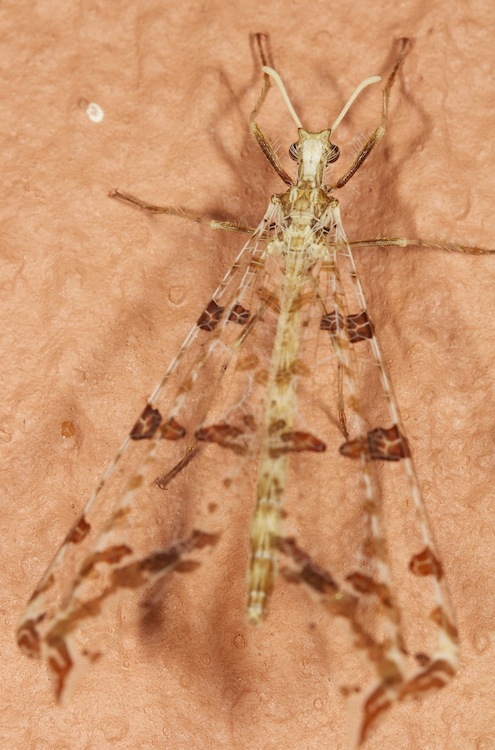
Oct. 2013 Kgalagadi
Characterized by pale prothorax, short white incrassate antennae and deeply falcate hindwings.
This species is fairly widespread in the drier regions of SA. Known from the Eastern, Northern and Western Cape provinces, Limpopo and Free State. Also from Botswana, Namibia and Zimbabwe.
It readily comes to light. Nothing is known about its larvae, although Cymothales larvae are generally found living in tree holes or rock ledges
Links:
https://lacewing.tamu.edu/neuropterida/ ... s-6415.pdf
Family Myrmeleontidae

Kgalagadi 2019

Oct. 2013 Kgalagadi

Oct. 2012 Kgalagadi

Oct. 2013 Kgalagadi
Characterized by pale prothorax, short white incrassate antennae and deeply falcate hindwings.
This species is fairly widespread in the drier regions of SA. Known from the Eastern, Northern and Western Cape provinces, Limpopo and Free State. Also from Botswana, Namibia and Zimbabwe.
It readily comes to light. Nothing is known about its larvae, although Cymothales larvae are generally found living in tree holes or rock ledges
Links:
https://lacewing.tamu.edu/neuropterida/ ... s-6415.pdf
Last edited by ExFmem on Mon Apr 13, 2015 10:11 pm, edited 2 times in total.


